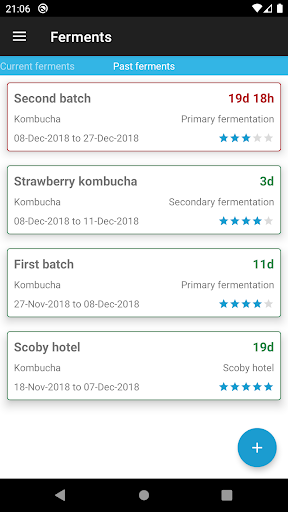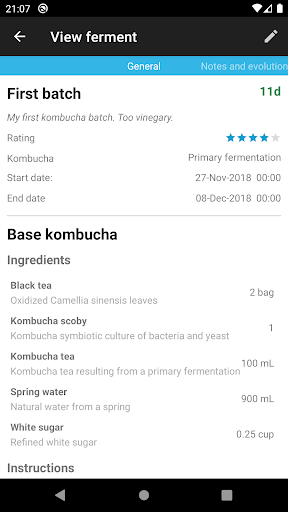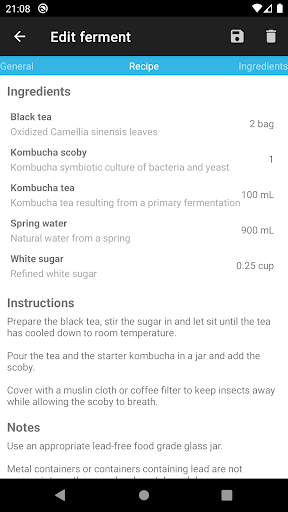You can now track the progress of your various batches, including primary and secondary fermentation and scoby hotels, to always get the best out of your favorite homemade beverages or ferments.
* Track your homemade kombucha, beer, jun, kefir, kimchi or other ferments
* Visualize progress of your batches
* Set ingredients and brewing conditions
* Keep an history of past batches
* Calculate alcohol by volume and corrected density
Premium version provides more functionalities and allows us to continue developing the app:
* Create your own recipes and assign them to your batches
* Setup alerts so that your brews never turn into vinegar
* Track pH, temperature, density and alcohol by volume
* Create your own ingredients
* Night mode
Provide positive and constructive feedback and send us your suggestions at [email protected] , we are more than happy to ensure you have the best experience and results possible!
Fermentation, the process of converting sugars into alcohol or acids through the action of microorganisms, has been a cornerstone of human civilization for millennia. From the earliest alcoholic beverages to the myriad of fermented foods we enjoy today, fermentation has played a vital role in shaping our culinary and cultural landscapes.
Kombucha: The Ancient Elixir
Kombucha, a fermented tea drink, has been consumed in Asia for centuries. It is made by adding a SCOBY (symbiotic culture of bacteria and yeast) to a mixture of black or green tea and sugar. The SCOBY ferments the tea, producing a slightly sweet, effervescent beverage rich in probiotics, antioxidants, and other beneficial compounds. Kombucha has gained popularity in recent years as a healthy alternative to sugary sodas and juices.
Beers: The World's Most Popular Alcoholic Beverage
Beer, brewed from fermented grains, is the most widely consumed alcoholic beverage globally. The brewing process involves converting the starches in grains (typically barley) into sugars through a process called malting. These sugars are then fermented by yeast, producing alcohol and carbon dioxide. The resulting beer can vary widely in flavor, aroma, and strength, depending on the type of grain, yeast, and hops used.
Ferments: A Culinary Tapestry
Beyond kombucha and beer, a vast array of fermented foods grace our tables, each with its unique flavor and health benefits. These include:
* Yogurt: A fermented milk product rich in probiotics, calcium, and protein.
* Cheese: Made by fermenting milk with bacteria or molds, resulting in a wide variety of textures and flavors.
* Kimchi: A spicy Korean fermented cabbage dish packed with probiotics and vitamins.
* Sauerkraut: A fermented cabbage dish popular in Central and Eastern Europe, known for its sour, tangy flavor.
* Miso: A fermented soybean paste used as a seasoning and base for soups and sauces in Japanese cuisine.
The Benefits of Fermentation
Fermentation not only enhances the flavor and shelf life of foods but also offers numerous health benefits. Fermented foods are rich in probiotics, live microorganisms that promote gut health and overall well-being. They also contain antioxidants, enzymes, and other beneficial compounds that may reduce inflammation, boost immunity, and protect against certain chronic diseases.
Conclusion
The world of fermentation is vast and multifaceted, offering a plethora of delicious and health-promoting foods and beverages. From the ancient elixir of kombucha to the globally beloved beer and the diverse array of fermented culinary creations, fermentation has played a pivotal role in human history and continues to enrich our lives today.
You can now track the progress of your various batches, including primary and secondary fermentation and scoby hotels, to always get the best out of your favorite homemade beverages or ferments.
* Track your homemade kombucha, beer, jun, kefir, kimchi or other ferments
* Visualize progress of your batches
* Set ingredients and brewing conditions
* Keep an history of past batches
* Calculate alcohol by volume and corrected density
Premium version provides more functionalities and allows us to continue developing the app:
* Create your own recipes and assign them to your batches
* Setup alerts so that your brews never turn into vinegar
* Track pH, temperature, density and alcohol by volume
* Create your own ingredients
* Night mode
Provide positive and constructive feedback and send us your suggestions at [email protected] , we are more than happy to ensure you have the best experience and results possible!
Fermentation, the process of converting sugars into alcohol or acids through the action of microorganisms, has been a cornerstone of human civilization for millennia. From the earliest alcoholic beverages to the myriad of fermented foods we enjoy today, fermentation has played a vital role in shaping our culinary and cultural landscapes.
Kombucha: The Ancient Elixir
Kombucha, a fermented tea drink, has been consumed in Asia for centuries. It is made by adding a SCOBY (symbiotic culture of bacteria and yeast) to a mixture of black or green tea and sugar. The SCOBY ferments the tea, producing a slightly sweet, effervescent beverage rich in probiotics, antioxidants, and other beneficial compounds. Kombucha has gained popularity in recent years as a healthy alternative to sugary sodas and juices.
Beers: The World's Most Popular Alcoholic Beverage
Beer, brewed from fermented grains, is the most widely consumed alcoholic beverage globally. The brewing process involves converting the starches in grains (typically barley) into sugars through a process called malting. These sugars are then fermented by yeast, producing alcohol and carbon dioxide. The resulting beer can vary widely in flavor, aroma, and strength, depending on the type of grain, yeast, and hops used.
Ferments: A Culinary Tapestry
Beyond kombucha and beer, a vast array of fermented foods grace our tables, each with its unique flavor and health benefits. These include:
* Yogurt: A fermented milk product rich in probiotics, calcium, and protein.
* Cheese: Made by fermenting milk with bacteria or molds, resulting in a wide variety of textures and flavors.
* Kimchi: A spicy Korean fermented cabbage dish packed with probiotics and vitamins.
* Sauerkraut: A fermented cabbage dish popular in Central and Eastern Europe, known for its sour, tangy flavor.
* Miso: A fermented soybean paste used as a seasoning and base for soups and sauces in Japanese cuisine.
The Benefits of Fermentation
Fermentation not only enhances the flavor and shelf life of foods but also offers numerous health benefits. Fermented foods are rich in probiotics, live microorganisms that promote gut health and overall well-being. They also contain antioxidants, enzymes, and other beneficial compounds that may reduce inflammation, boost immunity, and protect against certain chronic diseases.
Conclusion
The world of fermentation is vast and multifaceted, offering a plethora of delicious and health-promoting foods and beverages. From the ancient elixir of kombucha to the globally beloved beer and the diverse array of fermented culinary creations, fermentation has played a pivotal role in human history and continues to enrich our lives today.













